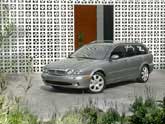Recent Articles
Popular Makes
Body Types
2005 Jaguar X-Type 3.0 Sportwagon
Baby Got Back
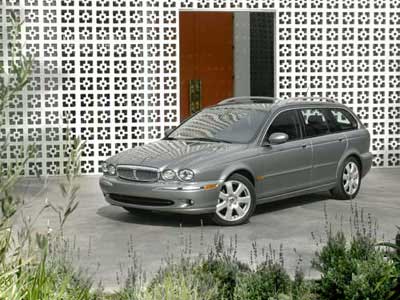
PALM SPRINGS, Calif. - Wants have become needs in the United States, a country where many icons of pop culture have far more money or beauty than talent or brains. To emulate these false heroes, we aspire to own, to experience, to endeavor for our own good rather than the greater good, and to boast as a substitute for self-confidence. If, for some reason, we cannot or will not own, experience, or endeavor, we're regarded as impoverished, narrow-minded, or lacking both ability and intelligence. Spartan living, chosen or forced, results in social rejection. And only chumps help those who cannot help themselves. Thus, materialism runs rampant in America, where the national motto might as well be, "Gotta get me some of that," despite record levels of personal bankruptcy. Denizens of the world's richest country are compelled to express success and superiority through possessions that convey wealth, from a residence in the right zip code and a luxury car in the garage to a cutting-edge home entertainment system in the home theater and clothing adorned with designer labels hanging in a walk-in closet large enough to double as a guest room. Not surprisingly, then, no matter how good or how bad a vehicle the 2005 Jaguar X-Type is, Americans will buy it, if for no other reason than it is a Jaguar. Styling cues, inside and out, are lifted directly from the XJ8 flagship sedan making the X-Type look much more expensive than its mid-30s price tag. Yet, despite the power of the chrome "leaper" hood ornament, almost half of the people who buy an X-Type choose a different marque after the lease expires, according to Jaguar. To stanch the exodus of potentially loyal Jaguar owners and to continue attracting new consumers to showrooms, Jaguar claims to have made more than 1,000 modifications to the X-Type that improve both quality and drivability. To find out, and to drive the latest variant, the 2005 Jaguar X-Type 3.0 Sportwagon, we traveled to the California desert for a day of driving, poking, and prodding.
Model Mix
Because Jaguar plans to sell only a few thousand copies of the 2005 X-Type 3.0 Sportwagon, it is offered in a single level of trim and with a limited number of options. Standard equipment includes leather upholstery, an eight-way power driver's seat, Sapele wood interior trim, and a wood-and-leather tilting and telescoping steering wheel. Heated exterior mirrors, a power sunroof, automatic single-zone climate control, power windows with one-touch operation, and a 120-watt Alpine audio system with a single-slot CD player are also part of the 2005 Jaguar X-Type 3.0 Sportwagon's starting price of $36,995 including destination charge. A Premium package is optional. It includes a trip computer, a programmable garage door opener, an eight-way power front passenger's seat, power lumbar support for both front seats, a memory feature for the seats and mirrors, and rain-sensing wipers. Other options include metallic or special-order paint, heated front seats, reverse park control, xenon headlights, Bluetooth wireless communications, a navigation system, a CD changer, stability control, and 18-inch wheels. Fully loaded, the 2005 Jaguar X-Type 3.0 Sportwagon costs nearly $47,000, and this is before adding dealer-installed options such as JaguarVoice voice recognition for the navigation, stereo, and climate systems; or a Motorola hands-free phone for those buyers opting to skip the X-Type's new Bluetooth wireless communications technology. The new-for-2005 Sport and VDP option packages are not available on the Sportwagon, and interesting options such as the gorgeous Melbourne 18-inch wheel design and the 320-watt Alpine audio system are not currently planned for this model. Jaguar did show reporters a Sportwagon equipped with the $3,000 Melbourne wheels, and it looked terrific. Company spokespeople claim that these wheels might be available through Jaguar dealers, if not the factory, in the future. Though Jaguar claims that the new X-Type 3.0 Sportwagon is a better value than comparably equipped models from Audi, BMW, and Mercedes-Benz, we'd like to point out that when loaded with every option, a 2005 Lexus IS300 Sportcross or 2005 Volvo V50 T5 AWD has trouble surpassing the Jaguar's base price and is nowhere close to the sticker of a loaded X-Type 3.0 Sportwagon.
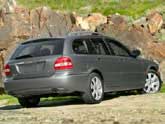
Hardware
Jaguar is proud to note that the 2005 X-Type 3.0 Sportwagon's V6 engine is the most powerful in its class, making 227 hp at 6,800 rpm and 206 lb.-ft. torque at 3,000 rpm. However, the X-Type 3.0 Sportwagon is also the heaviest vehicle in its class, weighing a smidge more than the next most powerful Audi A4 Avant 3.0 quattro. Essentially identical to the 3.0-liter motor under the hoods of the Jaguar S-Type 3.0, the X-Type 3.0 Sportwagon's engine drives power through a five-speed automatic transmission equipped with J-gate manual shifting. Fuel economy rates 18 mpg in the city and 24 mpg on the highway, though we'd guess that in real-world driving the X-Type 3.0 Sportwagon achieves lower numbers. Traction-4 permanent four-wheel-drive is standard, splitting power 40 percent to the front wheels and 60 percent to the rear wheels. The power split doesn't vary depending on wheel slip, and the X-Type 3.0 Sportwagon cannot send more power to one wheel on an axle than another, making it a rather simple and unsophisticated system. Jaguar has chosen to bias power delivery to the rear wheels to give the X-Type 3.0 Sportwagon the feel of a rear-wheel-drive car and to preserve steering feel. Also, less power flowing through the X-Type 3.0 Sportwagon's equal-length front driveshafts means a lower possibility of torque steer. Four-wheel-disc antilock brakes are standard and include Electronic Brake-force Distribution (EBD). Jaguar tunes the X-Type 3.0 Sportwagon's four-wheel-independent suspension with unique spring and damper settings to achieve an optimum mix of ride and handling. A variable-effort rack-and-pinion steering system guides the front wheels.
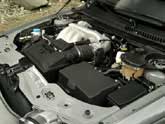
Design
Commonly, station wagons look just like the sedans upon which they are based in front, receiving unique bodywork from the front doors back. The 2005 Jaguar X-Type 3.0 Sportwagon is no different in this regard. Forward of the B-pillar, the X-Type 3.0 Sportwagon wears classic Jaguar looks that date to the 1968 XJ sedan. Quad headlights, a wide bifurcated grille, a fluted hood, a chrome "leaper" hood ornament, and side sculpting just below the beltline all make the X-Type 3.0 Sportwagon look more expensive than it is while simultaneously tying the car to the glory days of Jaguar design. Every part past the B-pillar is new - about a third of the car. Here, large "afterburner effect" taillights and a wide tailgate blade finisher over the rear license plate are said to be examples of a new, emerging Jaguar design vocabulary. Wheels are a strong five-spoke "Cayman" design measuring 17 inches. Photos don't do the X-Type 3.0 Sportwagon justice - the car is much more appealing in person. Inside, the cabin is decked out in standard X-Type fare. That means a wood-and-leather steering wheel, soft leather upholstery, Sapele wood veneers on the dash, and chrome detailing for extra sparkle.
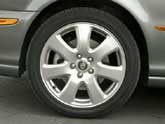
Interior
More than anything, it's the interior of the Jaguar X-Type that has turned critics and consumers off, despite its luxurious appearance. Any car owner, but particularly luxury car owners, should be able to expect a comfortable and appealing environment from which to conduct the business of driving. On the surface, the X-Type delivers. But scratch that thin veneer of luxury, and it's easy to see why this is an entry-level Jaguar. At least this 2005 iteration doesn't smell like a Ford inside, the way the last X-Type we drove did. But there are still quality issues that need to be addressed. Take, for instance, the glossy plastic bezels that surround the power window controls on the door panels. Scrape or tap your fingernail against that slippery plastic. It emits a thin, cheap sound that could be remedied by an inexpensive coat of matte-finish paint, the kind that Lexus douses upon Toyota Corolla parts to make them acceptable for use in the ES 330. (Or does Toyota affix cheap plastic to Lexus switchgear? It's difficult to tell.) Another example is the action of the turn signal and wiper stalks, which make a wet-sounding snap when used rather than a quiet, refined, fluid action. Hit the power door locks to enjoy a whirring symphony of mechanical parts rather than the solid and decisive thunk of most cars. Finally, the headliner and pillar trim is slightly fuzzy in a marketplace that has shifted to cleaner mesh materials. As with any Jaguar, the layout and design of the X-Type's controls could be improved. Housed on a wide central panel trimmed in wood, the splattering of dashboard buttons appears daunting at first, arranged uniformly rather than grouped logically by function. Also odd is the location of the trip computer switchgear, placed on the lower panel to the left of the steering column. Fortunately, everything is clearly marked and it doesn't take long to acclimate to the design. An adjustable armrest is built into the sliding center storage console lid. Storage underneath, however, is rather limited, a trade-off for big American-style cupholders that are placed to the right of the emergency brake. The X-Type's glovebox is a good size, and there are small storage slots in the front doors. Size constraints aren't limited to storage areas. In general, the Jaguar X-Type's cabin feels snug and intimate. There's not much legroom front or rear because the interior envelops its occupants. Fortunately, the front seatbacks are softly padded to be kind to the knees that are likely to be smashed against them. Four adults of average height are more likely to be comfortable in this car - four adults measuring six-feet in height are not. But no matter what size the occupant, the comfort that exists is fleeting. The seats are very firm and reasonably supportive, but a Jaguar should have soft seats that coddle occupants. And once you achieve a proper driving position, don't lose it - regaining the right settings is not easy. Households with multiple drivers should strongly consider the Premium package of options, which includes a handy memory feature. For the X-Type 3.0 Sportwagon, Jaguar worked hard to eliminate the road and exhaust noise that is common in vehicles with open cargo areas, and it has succeeded. The Sportwagon is, to our ears, quieter than the sedan, though when traveling uphill engine drone is still significant.
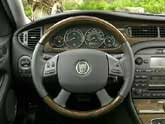
Utility
Jaguar is proud of its achievements with the X-Type 3.0 Sportwagon. Not only is this model purported to be the quietest X-Type available, but it offers the most utility, too. During our introductory drive, Jaguar specifically pointed to the design of the tailgate and the rear seats that can fold without removing the headrests as examples of the effort expended upon the X-Type 3.0 Sportwagon, which in its maker's opinion is much more than just a sedan with additional cargo space. Naturally, we tested these two features to see if they meet expectations. They did - and they didn't. Significantly, the tailgate features an independently opening glass window for added convenience, and it works. Reaching through the open glass to insert or remove smaller items is easy. Pop the tailgate open to reveal a beautifully trimmed cargo area with an aluminum scuff plate, twin loading lights, four spring-loaded tie-downs coated in chrome, an underfloor storage compartment complete with a 12-volt electrical outlet, and a cargo cover with a vertical net that slots into pegs in the roof. The liftover height is admirably low, and the rear quarter windows are vented for additional circulation when the pooch is along for the ride. It's also relatively easy to close the tailgate thanks to a handy recess molded into the edge of its interior trim. Despite this good stuff, the 2005 Jaguar X-Type 3.0 Sportwagon is capable of carrying just 50 cubic feet of cargo space with its 70/30 split-folding rear seats dropped, which is on par for the class but relatively unimpressive in the grand scheme of things. And contrary to Jaguar's claim, the rear seats don't fold without removing the headrests when a tall person sits in the front seats. Furthermore, the cargo cover is made of metal and is very hard to remove because it's heavy and maneuvering space is limited. And finally, for all the boasting about the design of the tailgate, we find it strange that six-footers can easily bonk their heads on the latch and on the outer edges of the raised tailgate. It only needs to open another inch or two to rectify this problem. If you need more than 50 cubes of cargo room, the 2005 Jaguar X-Type 3.0 Sportwagon is equipped with two roof-mounted cargo rails that can be outfitted with dealer-installed accessories to boost capability. But does a Jaguar owner really want to goof around with roof-mounted accessories?
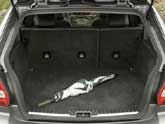
Safety
Safety is emerging as the single most important consideration when a consumer buys a new luxury car, according to a recent Gallup Poll. Good thing that the Insurance Institute for Highway Safety (IIHS) has given the X-Type its "Best Pick" seal of approval in the 40-mph crash test, and that the X-Type has scored well in crash-tests conducted by the federal government. Despite these showings, Jaguar has added more safety gear to the 2005 X-Type, but we'd like to see two additional items made available. New for 2005 are a front knee airbag for the driver and occupant sensors for the front passenger airbag. Dual-stage front airbags, side-impact airbags, and side-curtain airbags are all included as standard equipment, along with antilock brakes, electronic brake-force distribution (EBD), and Traction-4 permanent 4WD. Pretensioning and load-limiting front seatbelt retractors, three-point seatbelts for each seating position, and adjustable head restraints are also installed on every 2005 Jaguar X-Type. Stability control and reverse park control are options. What needs to be added is a brake assist feature that helps perform quicker panic stops. Also, in IIHS side-impact crash testing, the X-Type sedan received a "marginal" rating, but since the X-Type Sportwagon is structurally different, we cannot speculate that it would receive the same score as the sedan.
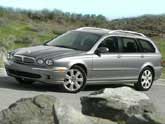
Road Test
Rain, combined with twisty mountain roads and more guts than brains, makes for an excellent test of a four-wheel-drive system, which comes standard on every 2005 Jaguar X-Type. We drove several variants of the X-Type on the freeways, city streets, and twisty mountain roads near Palm Springs, Calif., in wet and dry, sunny and cloudy conditions. As in other areas of assessment, this baby Jag both pleased and disappointed. The 2005 Jaguar X-Type 3.0 Sportwagon's drivetrain is not much of a treat. On paper, Jaguar brags that it's the most powerful in its class and provides acceleration stats to back up the claims, but the reality is that the X-Type feels sluggish to the seat of the driver's pants. Off the line, throttle response is delayed, and when the go-pedal is suddenly released during hard acceleration the engine "hangs," free-revving for a moment before winding down. The car is quick, but it's not lively in the way of a Lexus or BMW. On mountain roads, the engine and transmission don't communicate well, resulting in shift quality and shift points that are frustratingly unpredictable. Using the J-gate manual shift feature helped to make the X-Type a more pleasurable companion when climbing to the idyllic little town of Idyllwild. On the streets of Palm Springs where we drove less aggressively, the situation improved, with the transmission delivering butter-smooth shifts that get only somewhat more pronounced when using the transmission's Sport mode. All is not lost, however. The X-Type's standard Traction-4 permanent four-wheel-drive system operates unobtrusively, and wheel slip is not an issue since the power split is a constant 40-percent to the front wheels and 60-percent to the rears. Jaguar splits the power with a rearward bias to give the X-Type a rear-wheel-drive feel from behind the wheel, to limit any tendency toward torque steer up front, and to preserve Jaguar's trademark leaden steering feel which could be compromised if more energy flowed to the front tires. Indeed, the steering is sublime, with Jaguar's traditional heft, fluidity, and road feel shining through in spades. It's a pleasure to grip the X-Type's steering wheel, and resistance builds progressively off center. Driving down the highway, few corrections are required to keep the X-Type on course. During hard cornering, however, some sharp kickback comes through the wheel on bumps, and we also noticed a slight tendency to tug back to center on mid-speed sweeping turns. Fine adjustments to the responsive brakes are possible through a soft but well calibrated pedal. Ride quality is Germanic in nature, taut without being stiff, supple without being soft. There was more body lean during hard charging than expected, but the X-Type Sportwagon grips the road better than its owners will require. After several hours in the saddle, we gave the 2005 Jaguar X-Type Sportwagon a thumbs up for its four-wheel-drive system, its steering, its brakes, and its suspension. But the engine and transmission receive definite thumbs down.
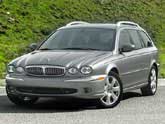
Wrap-up
When Jaguar introduced the X-Type for the 2001 model year, the car was plagued by reliability problems. Those teething pains, coupled with reportedly indifferent dealers, surely chased away many of those first-time Jag owners who might have selected another X-Type, or an S-Type, as their next conspicuous display of consumption. In our hectic, dual-income reality, broken cars and unresponsive dealers have an immediate and negative effect on making the next mortgage payment or winning that promotion. Neither did a Ford-sourced foundation and plummeting resale values make the X-Type a legitimate or intelligent choice, and it wasn't long before the reality of the X-Type overcame the fantasy of the X-Type. Today, Jaguar's baby is better than ever, now with more back. But despite the significant improvements made since the X-Type's debut, it's still an average effort at best, with styling and luxurious interior treatments remaining two of its strongest selling points. If nothing else, the 2005 Jaguar X-Type 3.0 Sportwagon adds versatility while expanding the model range, making it much easier to haul Sony plasma screen TVs, Sean John tracksuits and Louis Vuitton handbags back to the McMansion.
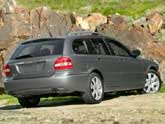
Specifications
Test Vehicle: 2005 Jaguar X-Type 3.0 Sportwagon Engine Size and Type: 3.0-liter V6 Engine Horsepower: 227 at 6,800 rpm Engine Torque: 206 lb.-ft. at 3,000 rpm EPA Fuel Economy: 18 city and 24 highway Curb Weight: 3,761 lbs. Max. Cargo Capacity: 50.0 cubic feet Max. Seating Capacity: 5 Competitors: Audi A4 Avant, BMW 325iT, BMW X3, Buick Rendezvous, Cadillac SRX, Chrysler Pacifica, Dodge Magnum R/T, Ford Escape Hybrid, Infiniti FX35, Land Rover Freelander, Lexus IS 300 SportCross, Lexus RX 330, Mercedes-Benz C-Class Wagon, Nissan Murano, Saab 9-2X, Subaru Legacy GT Wagon, Subaru Outback, Volkswagen Passat Wagon, Volvo V50, Volvo V70
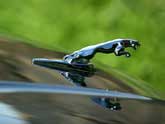
FAQs
Is the 2005 Jaguar X-Type 3.0 Sportwagon a good car? Competition in the entry-luxury segment of the marketplace is brutal, and when evaluated on its merits as a new product, the Jaguar lands mid-pack in a field of terrific vehicles. The answer to the question is a qualified yes, because the X-Type performs exceptionally well in some areas and less spectacularly in others. The updates for 2005 are palpable, but nothing short of a complete redesign could vault it to the top of its class. Why should I consider the Jaguar X-Type 3.0 Sportwagon? The Jaguar is handsome, and looks much better in person than in pictures. Though pricey, its appearance might indicate a price tag of thousands more. Plus, only a handful will trickle onto these shores, virtually guaranteeing exclusivity. Styling and exclusivity can outweigh many negatives for the Jaguar buyer. Why should I skip the Jaguar X-Type 3.0 Sportwagon? An unimpressive drivetrain, a cramped interior, hard seats, and some cheap bits and pieces will not please more practical buyers of the X-Type in the long run. Has Jaguar addressed quality concerns with the X-Type? J.D. Power & Associates has confirmed that the Jaguar X-Type's initial quality is up 32 percent since the model's debut in 2001. Driving the car, it's clear that the quality of the materials has improved and that the interior is assembled with greater care. But a better indicator of durability is long-term reliability, and Consumer Reports gave the X-Type its worst reliability rating in its April, 2004 issue. Draw your own conclusions. Photos courtesy of Erik Hanson
